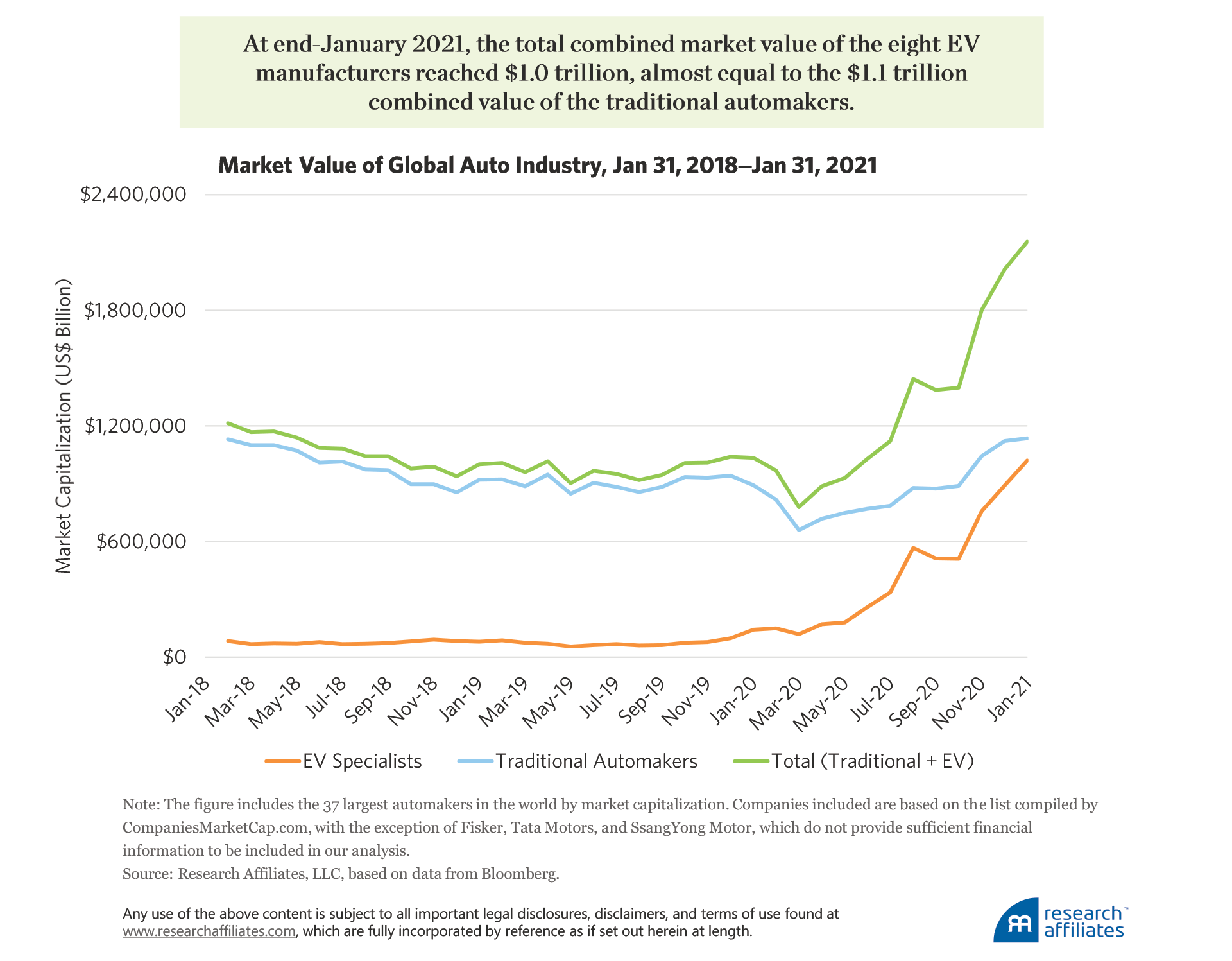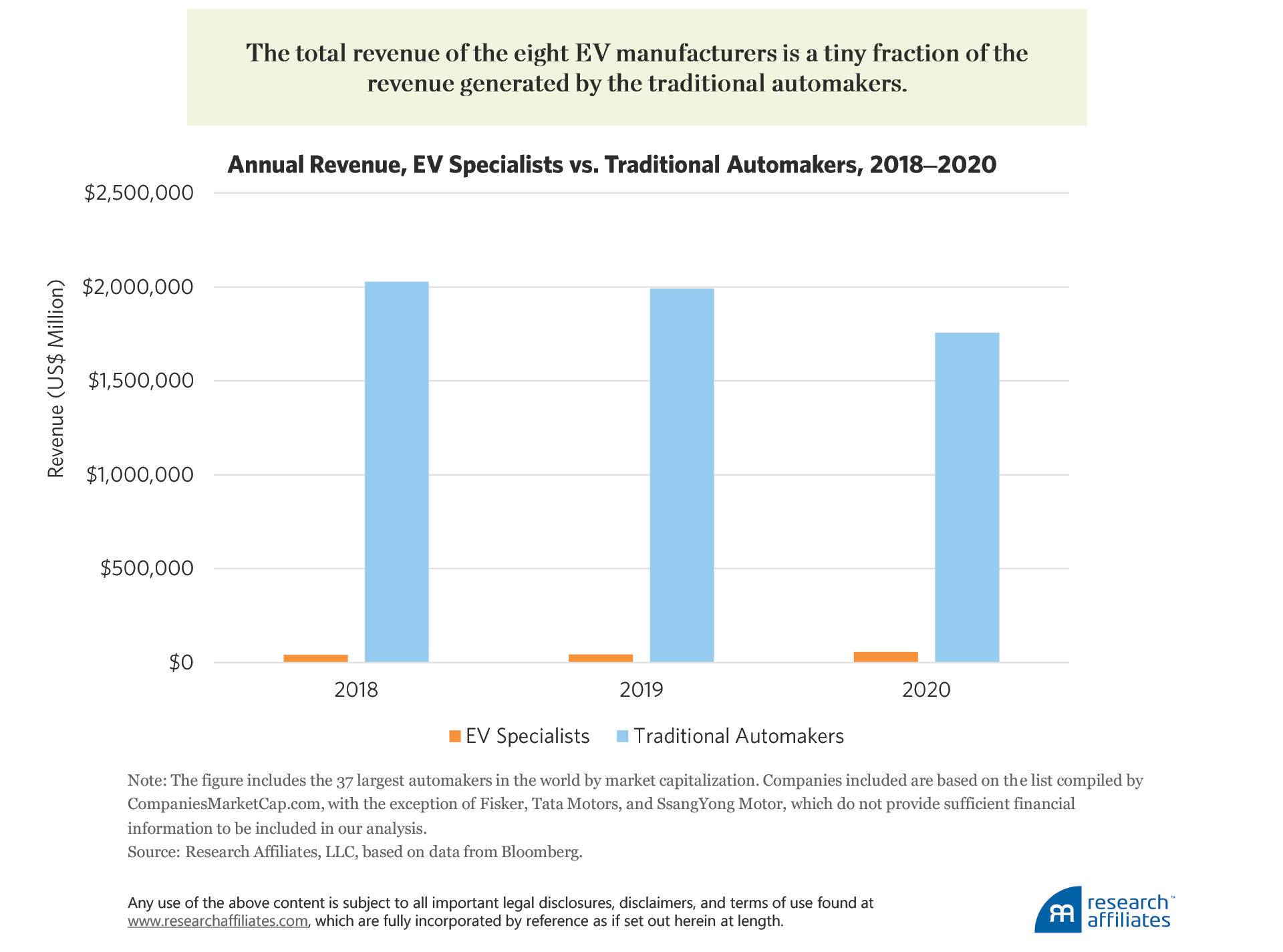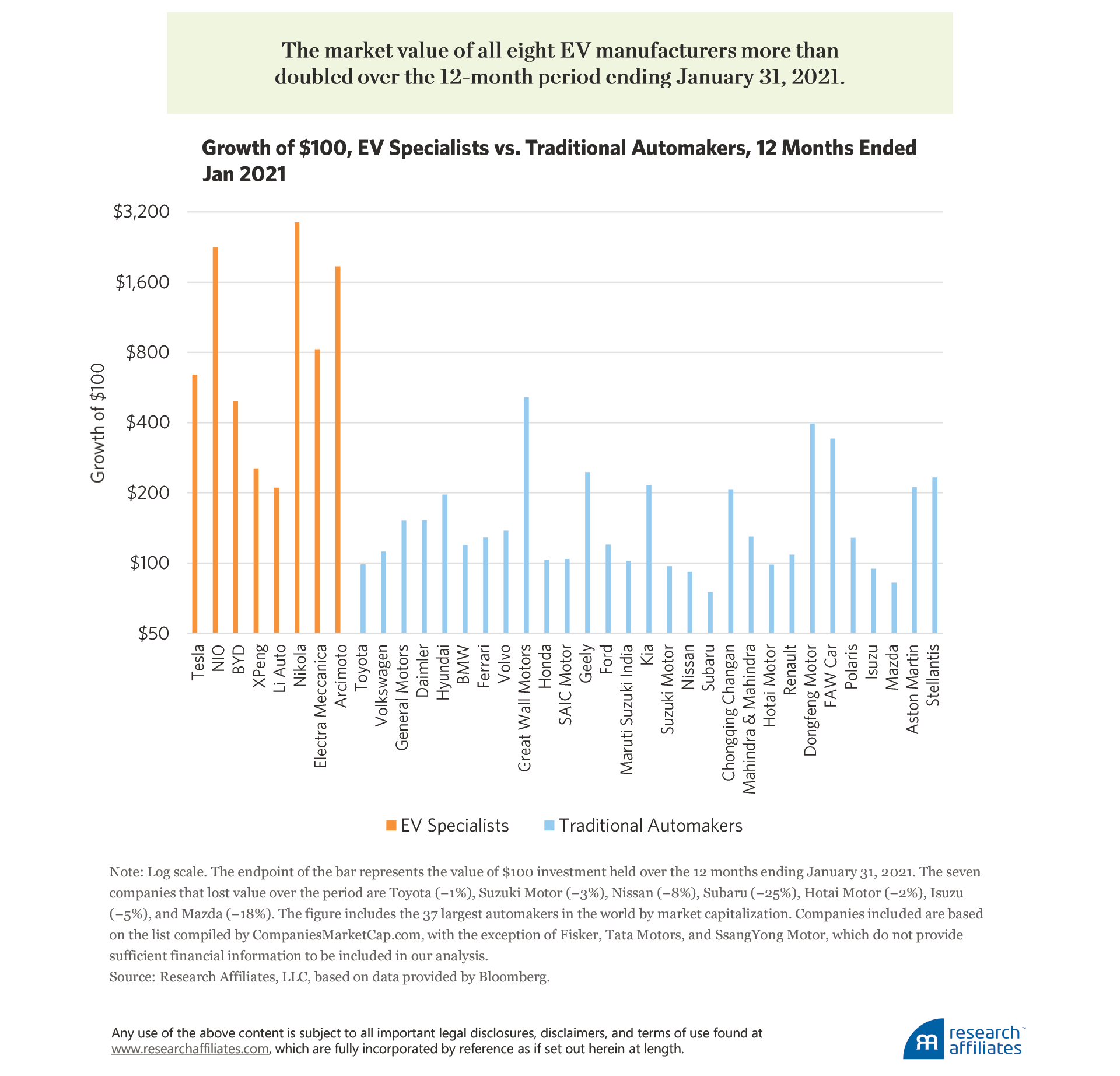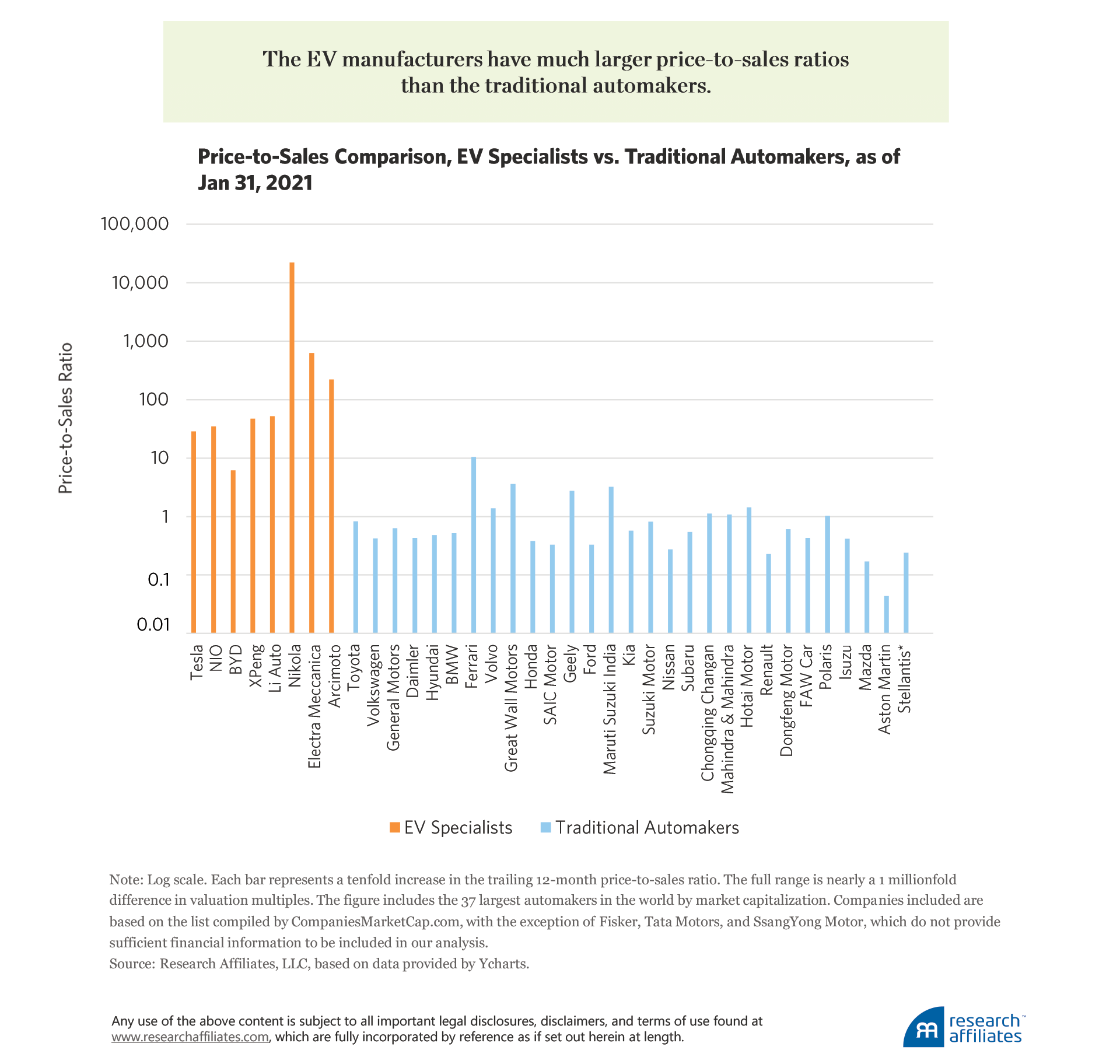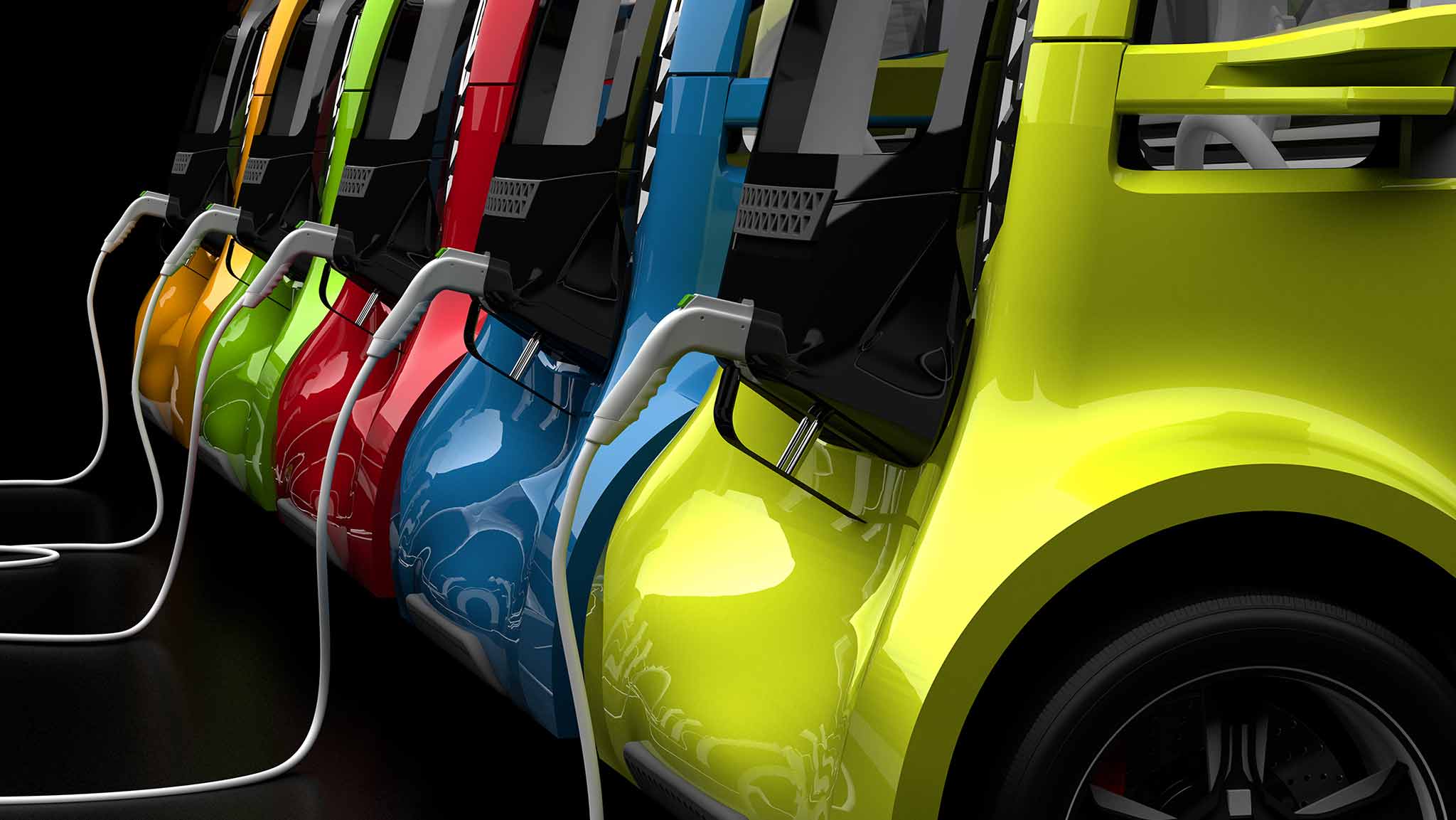
The “big market delusion” is when all firms in an evolving industry rise together, although as competitors ultimately some will win and some will lose.
The electric vehicle industry, with its astronomical growth in market-cap over the 12 months ending January 31, 2021, is a prime example of a big market delusion.
In the highly competitive and capital-intensive auto industry, the January 2021 valuations of electric vehicle manufacturers are simply not sustainable over the long term.
Final draft of this article was completed on February 16, 2021.
If a capitalist had been present at Kitty Hawk back in the early 1900s, he should’ve shot down Orville Wright; he would have saved his progeny money.
—Warren Buffett
Our objective is always to build big companies—if you don’t attack a big market, you’re highly unlikely to build a big company.
—Don Valentine, Founder of Sequoia
Big markets have a special allure for investors. They offer the promise of another Apple, Google, or Microsoft. But big markets also bring with them the threat of what Cornell and Damodaran (2020) call “the big market delusion.” Big market delusions generally begin with innovation or disruption that opens a new market, such as cannabis, or reinvents an old one, such as advertising. The hallmark of a big market delusion is when all the firms in the evolving industry rise together even though they are often direct competitors. Investors become so enthusiastic that each firm is priced as if it will be a major winner in the evolving big market despite the fact this is a fallacy of composition: the sum of the parts cannot be greater than the whole.1
The Lesson of the Airline Industry
An example of the big market delusion is the invention and development of aircraft. The development of the airplane was one of the great technological innovations of the early 20th century. In the years that followed, affordable air travel and transport revolutionized the way people lived and interacted as well as altered global commerce and trade. Air transport became a huge business, but airlines did not necessarily provide a wealth bonanza for investors.
From the beginning, the air travel business has been capital intensive and highly competitive. During good times, new airlines emerged and drove down profits. During bad times, many less well-capitalized companies folded. Over the course of the last century, virtually every company in the business either failed or merged into a larger airline, most of which also collapsed.
The simple fact, as Warren Buffett so cleverly stated, is that technology does not translate into great fortunes for investors unless it is associated with barriers to entry that allow a company to earn returns significantly in excess of the cost of capital for an extended period. Of course, Apple, Google, and Facebook are well-known examples of such technological success, but they are the exception rather than the rule. For a host of complicated reasons, these companies have been able to build moats, or barriers to entry, around their businesses. They also benefit from the fact their products can be produced with limited capital investment.
EV Industry: A Lesson in the Making?
Like airlines, the auto industry has historically been a competitive, capital-intensive business. For this reason, despite the global demand for their products, the traditional major auto manufacturers have tended on average to trade at book-to-market ratios near or below 1.0.2 From an industry perspective, we have little reason to believe that a change in the propulsion system from internal combustion engines to electric motors should have a pronounced impact on market competition or on the total industry valuation of the companies.
We examine the recent growth in market value for the global auto industry, focusing on the largest public auto companies by market capitalization.3 Over the three-year period ending January 31, 2021, the global auto industry gained 70% in market value, growing to $2.16 trillion. Interestingly, auto industry total value declined for the first two years, 2018 and 2019, of the three-year period. Traditional automakers absorbed almost all of the decline in value, while the market value of electric vehicle (EV) specialists remained flat.4
The year 2020 was a spectacular year for the auto industry in terms of valuation appreciation, as EV specialists became the market’s latest beloved companies and led a remarkable price run-up. As of January 31, 2021, the total market value of the eight EV specialists in our universe was $1.0 trillion, after year-over-year growth of 618%, almost on par with the $1.1 trillion combined value of traditional automakers.
In contrast to their astounding growth in market value, EV specialists’ combined total revenues remain as they have over the last three years at only a tiny fraction of the revenues generated by the traditional automakers: 1 to 42 on average over the three-year period. Furthermore, the entire industry’s total revenue fell in 2020 even as share prices skyrocketed.
Much of the increase in the industry’s market-cap was a result of the massive increase in Tesla’s market-cap. As of the end of January 2021, Tesla’s market capitalization had risen to $752 billion, placing it in the top 10 companies in the world by market value. At that market capitalization, Tesla accounted for about 75% of the total EV group’s market value and 35% of the market value of the entire auto industry. Such an immense market capitalization makes sense only if the expectation is that Tesla will come to dominate the entire auto industry, not just the EV market.5
Such an achievement requires that both Tesla’s brand and technology become so dominant that the company can earn profit margins that exceed those of Ferrari on a level of production exceeding that of Toyota. If that is the scenario reflected in Tesla's price, it should also be reflected in the falling valuations of its competitors, including competing EV specialists, whose market share will presumptively decline in favor of Tesla—however, the reverse is true. While Tesla’s stock price has been skyrocketing, the prices of competing EV firms have been too. Although the concurrent price increases of most conventional automakers could not be described as skyrocketing, they were rising handily, although a few did lose ground.
Let’s compare the growth of $100 over the 12 months ended January 31, 2021, if invested in each of the largest public auto companies by market capitalization.6 Seven conventional automakers lost market value (or more accurately did not fully recover losses from the COVID crash),7 while the market value of eight traditional automakers more than doubled.8
The market value of all eight of the EV specialists more than doubled over the 12 months ending January 31, 2021, and the market value of three of these rose more than tenfold: $100 invested in Nikola, a maker of zero-emission trucks with no clear plan as to when it would actually start selling trucks, grew by an astronomical 2800%; $100 invested in Nio, a Chinese EV start-up once near ruin, climbed 2150%; and $100 invested in Arcimoto, the maker of three-wheeler EVs, rose by 1770%.
The market values of two Chinese EV specialists, Li Auto and XPeng, first listed on the New York Stock Exchange in July and August 2020, respectively, jumped 110% and 150%, respectively, by the end of January 2021. The valuations of three Chinese traditional auto companies—Great Wall Motors, ChongQing ChangAn, and FAW Car—rose solely on the basis of their stated commitment to the EV market.
When we exclude Tesla from the EV specialist group’s $1 trillion market-cap at end-January 2021, the combined market value of the seven other EV companies is $268 billion, one-third Tesla’s value. What could we buy for $268 billion? We could buy not only Toyota—the largest traditional automaker by market capitalization ($228 billion at end-January 2021) and the most profitable automaker—but also Ferrari, the automaker with the highest profit margin. $268 billion is also the approximate market capitalization of all major German automakers—Volkswagen, Daimler, and BMW—which together account for 17.6% of global auto market sales.9
Exploding market value naturally leads to astronomically high valuation metrics. We compare the trailing 12-month price-to-sales ratio (P/S) for the 37 automakers in our analysis. Due to the massive price-to-sales ratios of the new EV manufacturers, we use a logarithmic scale. For instance, Tesla is valued at 28 times its 2020 sales—a far stretch compared to the average P/S of 1.1 of the traditional automakers.
The pricing delusion is not exclusive to Tesla. In fact, Tesla’s valuation multiple of sales is only a fraction of the multiple of some of its competitors. Nicola Motor, founded in 2015, with near-zero revenues and no actual production to date, is priced at 22,000 times sales, and profits are, of course, nowhere in sight. Electra Meccanica, also founded in 2015, the first maker of the electric three-wheeler, is priced at 600 times sales. Even new entrants XPeng and Li Auto are respectively priced at 47 times and 52 times sales, nearly twice the valuation multiple of Tesla. All of these companies are priced as if they are going to be huge winners, but they are competitors! They cannot all assume dominant market share in the years ahead!
Are Current Aggregate EV Valuations Sustainable?
EV global sales grew to 3.25 million units in 2020, an increase of 43% on a year-over-year basis. The rapid growth was partly driven by regulatory policy and a substantial package of incentives developed by various governments to promote zero-emission vehicles. In Norway, where the government has actively promoted EVs with generous tax incentives from the start, about half the vehicles registered in 2019 were electric, and by the end of 2020, EVs held about a 54% market share (Klesty, 2021).10 In the United States and across Europe, governments provided cash subsidies of differing amounts to boost EV sales. In China, the top EV manufacturers are state owned and therefore enjoy strong government backing and are supported by pro-EV strategic policies. These policies have led to a growing selection of EV models and low-cost offers in the domestic market, driving up EV sales growth (Pan, 2020).11
The momentum in EV adoption is also being positively impacted by changing consumer preference in favor of EVs as consumers grow more concerned about environmental pollution and global warming. Market disruption, consumer preference, and social benefits, which likewise characterized the early air travel industry, do not necessarily imply high market values for EV manufacturers. Competition drives profits toward the cost of capital unless new firms face daunting barriers to entry. Simply higher sales will not lead to higher profits if auto manufacturers face strict competition. At an aggregate level, as cities strive to become more energy efficient, light vehicle sales may actually fall.
In a competitive industry, market disruption benefits society at large, not necessarily the disruptors, and disruptors are often disrupted themselves in due course. Note that in 2000, Palm—the maker of the then-ubiquitous Palm Pilot—was spun off by its owner 3Com at a valuation larger than General Motors and larger than 3Com itself before the spin-off. After only a few years, Palm was put out of business by Blackberry, which after only a handful of years was itself on the ropes because of competition from Apple’s iPhone. Why should the EV market be immune to similar successive waves of disruption?
Tesla led global EV sales in 2020 with 15% of EV market share. In China, the world’s largest EV market, the Tesla Model 3 topped the 2020 sales list with a 6% EV market share. Even so, its sales remained small compared to the major traditional manufacturers such as Volkswagen and Toyota. To justify its current valuation, Tesla must grow by an order of magnitude (or two!), while increasing its margins at the expense of competitors. As we noted previously, the market is projecting a similar growth rate for most of Tesla’s EV competition.
The hallmark of a big market delusion is when all the firms in an evolving industry rise together even though they are often direct competitors.
”Even the prices of traditional manufacturers, such as Ford, General Motors, and Volkswagen, have risen during the first two months of 2021 solely on the basis of their stated EV plans.12 In China, it is only a matter of time before the state-owned EV companies begin to dominate the domestic market, supported by a range of factors including home-based consumption preference, potential protectionism, and a substantial price advantage. Of course, individual companies will have different degrees of success, even in an overall expanding industry. It is profoundly naïve to believe the auto industry, regardless of EV market share, will cease to be highly competitive.
Another explanation for Tesla’s astronomical valuation is that the market is valuing the company’s “full-stack” vertical integration business model and its ability to disrupt other markets (batteries! solar panels! space!).13 In particular, the full self-driving capabilities that Tesla is building, according to Elon Musk, could allow the future deployment of robotaxis for higher revenue per car (Levy and Kolodny, 2021).
What about the other EV specialists? Do they share a similar advantage in their business model? Do they have competing technological advantages that in time will even out the playing field with Tesla? If so, will the competing technological advantages grant each a high profit margin or will margins compress as a competitive market sorts out winners and losers?
The pricing delusion is not exclusive to Tesla.
”Today, virtually every EV automaker, in particular new entrants, are being priced as if they will be a winner. The most recent example is Lucid, which went public via a SPAC called Churchill Capital Corp. IV (CCIV) run by Michael Klein. Before the merger, the market capitalization of Lucid after the deal completed was estimated at $56 billion (Rana and Zainab, 2021). According to Lucid’s recent financial disclosures, the company expects to spend $10 billion over the next four years, an amount far exceeding the $4.4 billion Lucid was set to receive from the SPAC financing. Such a high cash burn reflects the aforementioned competitive and capital-intensive nature of the industry. To date, Lucid has yet to sell one car, but its market capitalization was initially expected to exceed Ford’s.
Conclusion
In 2020, the market capitalization of the worldwide auto industry more than doubled. The driving force was the “big new EV market.” As a result, the stock price of virtually every EV specialist, including more established firms such as Tesla as well as a host of new start-ups, all skyrocketed. Even the prices of traditional auto makers rose handily when they announced their own EV plans.
In our view, today’s electric vehicle industry is a classic example of the big market delusion. The EV phenomenon will not change the fact that the auto industry will remain highly competitive and capital intensive, and not every company can be a winner. Further, it remains unclear how simply switching the means of auto propulsion will make the entire light EV market more profitable, an assumption the market is now currently making. We suspect that as EV competition heats up, many companies will fail, as was the case in previous industry booms—whether autos, airlines, or technology—and with time the total value of the industry will recede to more reasonable levels.
Please read our disclosures concurrent with this publication: https://www.researchaffiliates.com/legal/disclosures#investment-adviser-disclosure-and-disclaimers.
Endnotes
- The big market delusion can also play out the opposite way so that the prices of all firms in an industry fall in lockstep. A good example is financial services during the 2008–2009 global financial crisis. In March 2009, at the market’s bottom, the risk of any single financial services company going bankrupt was high. The outlook for the industry as a whole, however, was quite good because financial services play a central, crucial role in the global economy. For any individual company that failed, the remaining companies in the industry would assume the lost market share.
- The weighted-average (weight by market capitalization) of book-to-market ratios for traditional major automakers range from 0.35 to 1.38, with a mean value of 0.69, based on our data period of 1982–2020.
- We started with a list of the 40 largest automakers in the world by market capitalization as provided by CompaniesMarketCap.com and divided them into two groups: electric vehicle specialists (EV-focused) and traditional automakers. Our analysis does not include Fisker, Tata Motors, and SsangYong Motor because they do not report sufficient financial information for our study period.
- The decline in the auto industry’s global market value reflected falling demand, particularly in China, the world’s largest auto market.
- Tesla’s industry domination could happen if regulations lead to the gradual elimination of petroleum-based vehicles and if future fleets of autonomous robotaxis are all EVs. That said, conventional automakers also make EVs and currently produce and sell more EVs than Tesla does.
- The same 37 companies we use to calculate the aggregate market value of the global auto industry.
- The seven conventional automakers that lost market value over the 12 months ending January 31, 2021, are Toyota (−1%), Suzuki Motor (−3%), Nissan (−8%), Subaru (−25%), Hotai Motor (−2%), Isuzu (−5%), and Mazda (−18%).
- The eight conventional automakers whose market value more than doubled over the 12 months ending January 31, 2021, are Great Wall Motors (415%), Geely (145%), Kia (116%), Chongqing Changan (107%), Dongfeng Motor (296%), FAW Car (242%), Aston Martin (112%), and Stellantis (133%). PSA (Peugeot) and Fiat Chrysler merged in early 2021 to form Stellantis.
- In 2020, Volkswagen sold 9.31 million vehicles, BMW sold 2.3 million, and Daimler sold 2.55 million.
- Norway has no import tax on pure electric and fuel-cell vehicles, and electric cars are not subject to the 25% VAT.
- China has also relaxed its regulatory rules on EVs. In China, EVs are not subject to registration restrictions or driving bans on certain days, which are the type of rules that usually apply to vehicles with combustion engines.
- Ford has pledged to be completely all-electric in Europe by 2030. General Motors has pledged to phase out all gasoline- and diesel-powered vehicles by 2035 and to be carbon-neutral in all global operations by 2050. Volkswagen plans for 20% of its total sales to be electric cars by 2025.
- Tesla’s atypical business is a model of vertical integration, including hardware manufacturing (autos and batteries), software development (e.g., autopilot), insurance, repair services, and fast charging.
References
Cornell, Bradford, and Aswath Damodaran. 2020. “The Big Market Delusion: Valuation and Investment Implications.” Financial Analysts Journal, vol. 76, no. 2:15–25.
Klesty, Victoria. 2021. “Electric Cars Rise to Record 54% Market Share in Norway in 2020.” Reuters.com (January 5).
Levy, Ari, and Lora Kolodny. 2021. “Elon Musk Explains How Self-Driving Robotaxis Will Justify Tesla’s Massive Valuation.”CNBC.com (January 27).
Pan, Frank. 2020. “How China’s Electric Vehicle (EV) Policies Have Shaped the EV Market.” Sustainalytics.com (July 31).
Rana, Akanksha, and Noor Zainab Hussain. 2021. “Lucid Motors’ SPAC Skids as $56 Billion Valuation Sparks Bubble Concerns.” Reuters.com (February 23).
